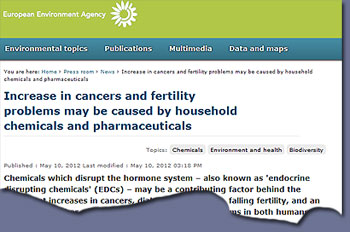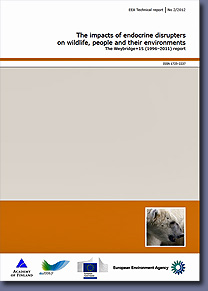Call For Banning Common Household Chemicals Suspected Of Causing Increased Cancer Rates
The European Environment Agency (EEA) undertook a review of recent scientific literature into the chemicals which disrupt the hormone system – also known as 'endocrine disrupting chemicals' (EDCs).
 The review, published in May this year, found that EDCs may be a contributing factor behind the significant increases in cancers, diabetes and obesity, falling fertility, and an increased number of neurological development problems in both humans and animals.
The review, published in May this year, found that EDCs may be a contributing factor behind the significant increases in cancers, diabetes and obesity, falling fertility, and an increased number of neurological development problems in both humans and animals.
Andreas Kortenkamp, who contributed to the review, is professor at Brunel University's Institute for the Environment. In an article published in the Guardian newspaper early this year, he argued for further legislation with regard to the harmful chemicals which pervade our home and environment.
He said,
‘This comes at a time of important changes in chemicals legislation, with the European parliament deciding that pesticides should be banned if they possess endocrine-disrupting properties. An intense debate about defining the criteria that should be used to classify a chemical as an EDC has ensued between EU member states, industry and environmental groups.
The stakes are high. Depending on how strictly the criteria are defined, the chemical industry will not be able to market certain pesticides. An example is the fungicide prochloraz which is widely used in agriculture and gardening. Other chemicals present in household plastics, such as certain phthalates, might be placed on severe restrictions.’
His article highlighted the fact that in this country ‘ it seems that commercial interests are more important.’
He explains:
‘The Health and Safety Executive's chemicals division has, together with German authorities, tabled proposals for regulating pesticides that closely follow those developed by industry. Identifying a substance as an EDC will have a great financial impact, they say, so only the most potent substances should be given endocrine disrupter status.’
He said the HSE’s view does not take into account of ‘…..recent research, which has made great progress in defining the scale of the problem. For example, it is now estimated that more than 2,000 chemicals in use today could interfere with the male sex hormone. The implications for young men could be serious: potential consequences include impaired fertility, malformations of sex organs and testicular cancer.'
He adds:
‘Similarly, there are EDCs that disrupt female hormone systems, with consequences for breast cancer and fertility. Several studies found that dioxins, the drug DES and PCBs increase the risk of breast cancer. Pesticide spraying by farm workers in the US has been linked in some studies to prostate cancer. These days it is hard to find a river in Britain where male fish are not feminised by EDCs in waste water from our houses.’
But Government and industry responses to criticisms of the risk to health do not take into account the ‘cocktail effect’ which is were numerous chemicals we are exposed to and even ingest, act together and contribute to a far more harmful effect.
‘Many chemicals can contribute to an overall effect, even at exposures where each of these substances alone does not cause harm. This makes it extremely difficult to identify safe exposures, and means that apparently low levels could contribute to risks.’ his article warns.
 The EEA report, emphasises the gaps in knowledge and the fact that it extremely difficult to identify the true extent of risks to humans and wildlife, because the number of relevant EDCs is unknown.
The EEA report, emphasises the gaps in knowledge and the fact that it extremely difficult to identify the true extent of risks to humans and wildlife, because the number of relevant EDCs is unknown.
But the issue in relation to how EDCs effect us before birth are the mst concerning.
Professor Kortenkamp explains:
‘.. even with today's analytical technologies it is almost impossible to fully understand the exposures that occurred in the womb, because by the time diseases become apparent many of the potentially causative substances have disappeared from our bodies. In these situations, scientists have to fall back on laboratory studies with rodents even though adequate tests do not exist for many diseases of the endocrine system.’
Commenting upon the HSE,’s stance he said:
‘The HSE's website says its primary aim is to ensure health protection of people and the environment, but by focusing only on the most potent EDCs, it's clear that the bias is already strongly in favour of commercial interests. Only a few chemicals would qualify for restriction if the UK criteria were to be adopted, as shown by an analysis from the Danish government. Most EDCs would remain unregulated.’
His article concludes by demanding that Government’s protect the public, saying that ‘.. economic pressures should be secondary to health protection needs.’
‘Considering the high stakes for human and wildlife health, and the vast costs of dealing with the diseases likely to be attributed to these chemicals, the UK authorities have to be more cautious.’
The full article can be read here
Further info on Diethylstilbestrol (DES) can be found here
Further info on Polychlorinated biphenyl
(PCB) can be found here
You can download the European Environment Agency’s report from the E-Library Database by using the keyword ‘endocrine’
Source: The Guardian / European Agency Environment



